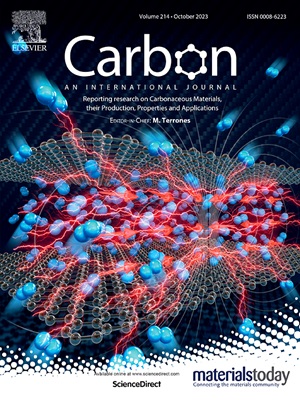Graphene-armored nickel nanoparticles promote stable and selective butadiene hydrogenation
IF 10.5
2区 材料科学
Q1 CHEMISTRY, PHYSICAL
引用次数: 0
Abstract
A facile pyrolysis strategy utilizing citric acid was employed to fabricate nickel nanoparticles encapsulated by graphene layers (Ni@C) for selective butadiene hydrogenation. Systematic adjustment of calcination temperatures (873–1173 K) enabled control over Ni particle size (12.8–27.5 nm) and carbon encapsulation thickness. Catalysts synthesized at higher temperatures (1073–1173 K) demonstrated much superior performance, achieving 97 % butene selectivity and retaining >98 % initial activity over 100 h at 373 K. In contrast, catalysts carbonized at lower temperatures (873–973 K) displayed rapid deactivation linked to excessive carbon deposition. Kinetic insights indicated that enlarged Ni particles strengthened butadiene adsorption while the relative adsorption strength between butadiene and intermediate product – butenes were increased, thereby suppressing over-hydrogenation to butane. The graphene overlayers not only effectively mitigated Ni oxidation when exposed to air, but also prevent metal agglomeration under hydrogenation conditions, ensuring structural integrity. Comparative evaluations underscored the superiority of well-designed graphene-capped Ni catalysts over traditional systems in balancing selectivity and longevity. This study advances the rational design of encapsulation-engineered catalysts for industrial hydrogenation processes requiring precise product control.
石墨烯包覆的纳米镍促进稳定和选择性的丁二烯加氢
利用柠檬酸制备了石墨烯包封镍纳米颗粒(Ni@C),用于选择性丁二烯加氢。系统调节焙烧温度(873-1173 K)可以控制Ni粒度(12.8-27.5 nm)和碳包封厚度。在较高温度下(1073-1173 K)合成的催化剂表现出更优异的性能,在373 K下,在100小时内,丁烯选择性达到97%,初始活性保持98%。相比之下,在较低温度(873-973 K)下碳化的催化剂表现出与过量碳沉积有关的快速失活。动力学分析表明,增大的Ni颗粒增强了对丁二烯的吸附,增加了丁二烯与中间产物丁烯的相对吸附强度,从而抑制了丁烷的过加氢反应。石墨烯覆盖层不仅能有效减缓Ni暴露在空气中的氧化,还能防止金属在氢化条件下团聚,确保结构的完整性。对比评估强调了精心设计的石墨烯覆盖镍催化剂在平衡选择性和寿命方面优于传统系统。该研究为需要精确产品控制的工业加氢过程提供了合理设计的封装工程催化剂。
本文章由计算机程序翻译,如有差异,请以英文原文为准。
求助全文
约1分钟内获得全文
求助全文
来源期刊

Carbon
工程技术-材料科学:综合
CiteScore
20.80
自引率
7.30%
发文量
0
审稿时长
23 days
期刊介绍:
The journal Carbon is an international multidisciplinary forum for communicating scientific advances in the field of carbon materials. It reports new findings related to the formation, structure, properties, behaviors, and technological applications of carbons. Carbons are a broad class of ordered or disordered solid phases composed primarily of elemental carbon, including but not limited to carbon black, carbon fibers and filaments, carbon nanotubes, diamond and diamond-like carbon, fullerenes, glassy carbon, graphite, graphene, graphene-oxide, porous carbons, pyrolytic carbon, and other sp2 and non-sp2 hybridized carbon systems. Carbon is the companion title to the open access journal Carbon Trends. Relevant application areas for carbon materials include biology and medicine, catalysis, electronic, optoelectronic, spintronic, high-frequency, and photonic devices, energy storage and conversion systems, environmental applications and water treatment, smart materials and systems, and structural and thermal applications.
 求助内容:
求助内容: 应助结果提醒方式:
应助结果提醒方式:


